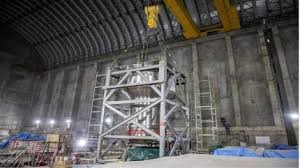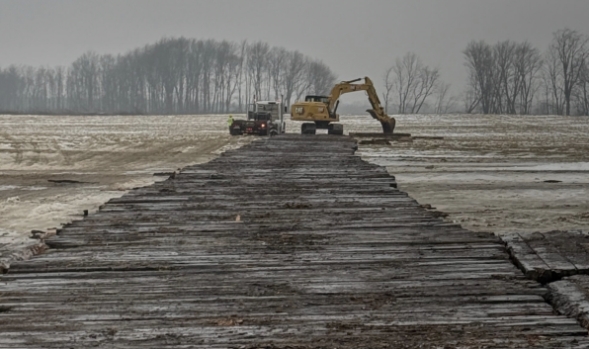
Key equipment is being installed at the MBIR (Mnogotselevoi Bistrii Issledovatelskii Reaktor) research reactor under construction at the Scientific Research Institute of Atomic Reactors (NIIAR – Nauchno Issledovatelskii Institut Atomnikh Reaktorov) in Dimitrovgrad. The project is being implemented within the framework of the Comprehensive Programme for the Development of Engineering, Technology & Scientific Research (RTTN – Razvitii Tekhniki Tekhnologii I Nauchnikh Issledovanii) in the field of the use of atomic energy in the Russian Federation to 2024.
Two 38-tonne intermediate heat exchangers 9 metres high and 2.5 metres in diameter have been installed in the design position. The equipment was installed on support rings with a deviation of no more than 1 mm per metre. Also, drums for fresh and used assemblies have been installed, each weighing 16 tonnes.
The fresh assembly drum is designed to heat the fuel assemblies (TVS – TeploVidelyayushshaya Sborka) in an inert gas environment before being installed in the reactor core. And the used fuel drum is designed to heat used fuel unloaded from the reactor in an inert gas medium,” said Sergei Kiverov, Deputy Director for Facilities under Construction at NIIAR. “The drums are part of the transport and technological system, which means that their installation … will allow concreting the central hall floor area of about 100 square metres paving the way for installation of equipment located at a height of 11.9 metres.”
The reactor pressure vessel was installed in January 2023 and installation of the reactor building containment dome was completed the following October. In the reactor building, work was now underway Work has also been carried out in the reactor unit on reactivation and tilting of the MBIR reactor core basket. A slipway with a basket has been installed in the central hall at a height of 13.20 metres, preparations are underway for welding the melt trap.
The 150 MWt multi-purpose sodium-cooled fast neutron MBIR reactor will be the world’s largest facility of its kind. It is expected to provide the nuclear industry with a modern and technologically advanced research infrastructure for the coming 50 years. Its unique technical characteristics will make it possible to solve a wide range of research problems to support the development new competitive and safe NPPs, including fast reactors based on closing the nuclear fuel cycle. Research time needed at the new reactor will be several times less in comparison with the currently operating installations.
During the construction of the MBIR, Rosatom’s state of the art technologies and new management approaches have been used including integrated remote monitoring tools such as photography from unmanned aerial vehicles and laser scanning. As a result of this and close interaction between scientists and builders, the overall project is ahead of schedule.
Rosatom says the construction of MBIR is the most important project for the long-term development of the experimental base of Russia’s domestic nuclear industry, “which will ensure Russia’s leadership in the development of innovative reactor technologies for the next half century”.
MBIR will be the basis of an international research centre (ICC MBIR). It will replace the BOR-60 experimental fast reactor that has been in operation at NIIAR since 1969. BOR-60 is due to close in 2025. MBIR will be used for materials testing for Generation IV fast neutron reactors. It will be capable of testing lead, lead-bismuth and gas coolants and will enable reactor and post-reactor experiments, perfecting technologies for the production of isotopes and modified materials.
The accession of new participants to the MBIR project takes place by signing a consortium agreement. Russian and foreign partners will be given the opportunity to conduct the experiments necessary for their national programmes without the need for direct ownership of the reactor facility and the corresponding obligations to ensure its safe operation or the control and accounting of nuclear materials. Negotiations are underway with potential partners from the CIS and China.







